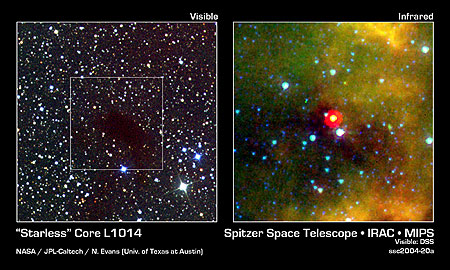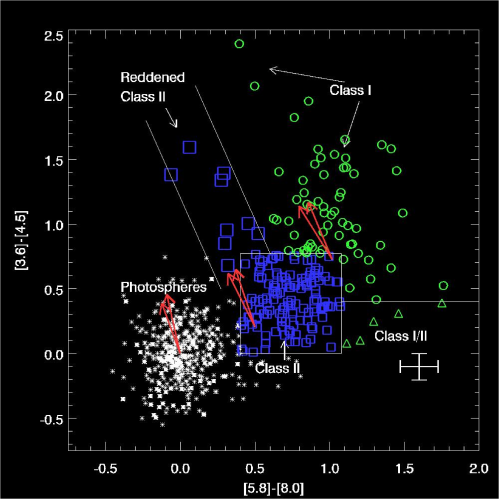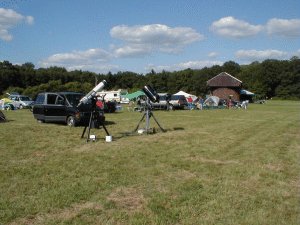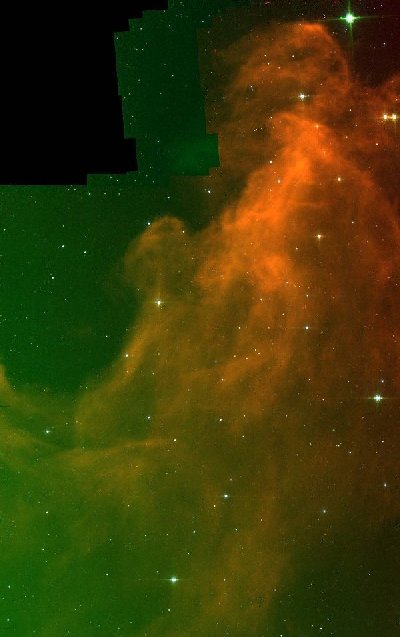IC 2118 Current Research Activities
Contents
- 1 Some more of the basics behind what we are doing!
- 2 Color-Color Plots
- 3 Writing the Research Paper for IC2118
- 4 Information for Oil City High School meetings
- 4.1 Proposal for Radio Observations of T-Tauri Candidates in IC2118
- 4.2 T-Tauri/IC2118 Presentation for Astroblast 2007
- 4.3 Monitoring T-Tauri Stars using the Perth Obervatory Telescope
- 4.4 Chandra X-Ray Data
- 4.5 Kitt Peak H-alpha Data
- 4.6 USNO U, B, V, R, and I Data
- 4.7 Outflows or Jets
- 4.8 Multi Wavelength Composite Images
Some more of the basics behind what we are doing!
Here is an image of an object called L1014. This object used to be known as a "starless core." On the left is a picture in visible light, and you can see why people thought it was starless. On the right is a picture from Spitzer clearly revealing a baby star inside (it's the bright red thing)!
When the protostar enters the next stage, labeled in the figure as the T Tauri stage, it’s still gaining mass and contracting slowly because material is still falling onto it, but it begins to eject gas in two giant gas jets, called bipolar flows. These jets and stellar winds eventually sweep away the envelope of gas still surrounding the protostar. In the surrounding disk protoplanets are beginning to form. (d) Astronomers call this phase the T Tauri phase, but some objects with jets are also "Class I"; T Tauris are also either "Class II" (for ones with thick disks) or "Class III" (for ones with thinner disks).
Leftover material in the disk surrounding the star clumps together and undergoes many collisions until most of the material has been swept up by objects orbiting the star, such as planets, asteroids and comets. (e)
The star’s life so far has been governed by the continuous inward pressure of gravity. The gravitational pressure keeps compressing the gas into a smaller and smaller volume, making it hotter and hotter in the core. As soon as the temperature in the core of the protostar becomes great enough, about 1,000,000 K, nuclear fusion begins. Nuclear fusion is the process in which small atomic nuclei combine to make larger atomic nuclei, releasing lots of energy. Inside the star, the gravitational pressure eventually pushes 4 protons and 2 electrons so close together that they fuse together to make helium. When this nuclear fusion begins, finally the star has a way to "fight back" against gravity. So much energy is released in this reaction that it enables the star to "push back" with an outward radiation pressure that balances the inward push of gravity. The protostar is now a full-fledged star, fusing hydrogen into helium in its core. (f) The star will stay the same size until it runs out of nuclear fuel in the core (all of the hydrogen has been converted into helium). Then, the pressure from gravity takes over again, pushing in on the star.
Star formation can be triggered by the collapse of large clouds of gas and dust. Sometimes the clouds collapse all by themselves (due to gravitational forces within the cloud) and sometimes they collapse because they’ve been pushed by the radiation and winds from stars that have already been formed. This seems to be the reason behind the star formation in IC 2118. It seems to have been triggered by some combination of forces from the main Orion Nebula Cluster (the fuzzy patch in the sword) and Rigel.
Color-Color Plots
The magnitude scale measures the brightness of a star. The system for assigning magnitude numbers was developed in ancient times. The brighter the star is, the lower its magnitude.
An infrared color-color diagram is a useful tool in (a) finding the young stars, and (b) making a guess at the age of young stars. In this diagram astronomers compare the differences in magnitude of a star at two wavelengths to the difference in magnitude of the same star in two other wavelengths.
Here is an example of a color-color plot using IRAC colors. By making models of stars, astronomers have determined that a star's position on this graph is related to its age since the star’s position on the graph is related to how warm or cool it is. Stars start out as cool (or red) and become warmer (bluer), therefore they shift positions on the diagram as they age.
--Class 0: these are very young stars, still buried deep inside their cocoon of gas.
--Class I: these are protostars surrounded by an infalling envelope of gas.
--Class II: these protostars, now in the T-Tauri stage, have developed protoplanetary disks.
--Class III: these are nearly fully developed stars, with just a remnant disk (and possibly planets) surrounding them.
Homework: Your own literature search!
Search the literature for references to IC 2118. Nearly all the astronomical literature is online at Harvard’s ADS website. (http://adsabs.harvard.edu) The ADS website allows you to search for abstracts using either names (IC2118) or coordinates (Ra/Dec). The website will let you look at older full papers, but only abstracts for recent papers. If there is a recent paper you wish to read, you will need to connect through a local university.
- Find all papers by Maria Kun. Which are refereed, and which are conference proceedings?
- Find all papers involving IC 2118.
- Find Hartmann et. al, 2005, ApJ, 629, 881.
- Search the web for observations in other wavelengths, not just images but photometry as well. Some good places to start are:
- Gator, at IRSA, provides access to 2MASS, IRAS, and other wavelengths (including some large Spitzer surveys). This site can be accessed at: http://irsa.ipac.caltech.edu/applications/Gator/
- USNO provides optical magnitudes, if they exist. Make sure to retrieve tables, not images. This site can be accessed at: http://www.nofs.navy.mil/data/FchPix/
- Skyview provides images at other wavelengths. This site can be accessed at: http://skyview.gsfc.nasa.gov
Writing the Research Paper for IC2118
Information for Oil City High School meetings
The next meeting should be at 4 0'clock pm wednesday the 25th at matt walentosky's house. (Specifically for people going to California, so we can plan out events and travel...)
Proposal for Radio Observations of T-Tauri Candidates in IC2118
SUPPORT INFORMATION - T-Tauri Candidates Emit Radio
FROM MATT WALENTOSKY 6/30/2007 @ 2:30 PM - Two Abstracts Below
Title: Radio emission from pre-main-sequence stars Authors: Skinner, Stephen Lee
Affiliation: AA(Colorado Univ., Boulder.) Publication: Ph.D. Thesis Colorado Univ., Boulder. Publication Date: 01/1992 Category: Space Radiation Origin: STI
Abstract This study focuses on the properties and physical origin of radio continuum emission from pre-main-sequence (PMS) stars. These are young stars, typically less than a few million years old, and are still in a phase of gravitational contraction that will ultimately be halted by the onset of hydrogen burning in their cores. First, I address the question of the origin of centimeter continuum emission in intermediate mass (approx. equal to 3-20 solar mass) PMS stars, the so-called 'Herbig Ae/Be stars'. A high-sensitivity radio survey of 57 such stars was undertaken using the Very Large Array and Australia Telescope, resulting in the detection of twelve stars. These observations provide a homogenous data base consisting of information on source sizes, radio luminosities, variability timescales, circular polarization, and spectral energy distributions in the wavelength range 2-20 cm. Using these data along with previously published spectroscopy, I conclude that centimeter radio emission from Herbig Ae/Be stars is predominantly thermal and in many cases wind-related. An unexpected result of the above program was the serendipitous detection of circularly polarized radio emission in the low mass (approx. equal to 1 solar mass) PMS star Hubble 4, a member of the class of 'weak-lined T Tauri stars' (WTTS). This provides some of the most convincing evidence to date for the existence of ordered magnetic fields in WTTS. In a second observing program, I have searched for evidence of cold (less than or equal to 50 K) circumstellar dust around WTTS, which might exist in the form of remnant disks. Of the sixteen WTTS that were observed in the wavelength range 450-1100 microns using the James Clerk Maxwell Telescope, only V836 Tau was detected. Its spectral energy distribution longward of 10 microns is consistent with that expected for a flat, axisymmetric circumstellar disk of mass approx. equal to 0.04 solar mass (= 42 Jupiter masses). This star may be a rare example of an object in which disk dispersal is underway, but not yet complete.
Title: Centimeter Radio Emission from Low-Mass Weak T Tauri Stars in Taurus-Auriga
Authors: Chiang, Eugene; Phillips, R. B.
Affiliation: AA(MIT), AB(MIT Haystack Observatory) Publication: American Astronomical Society, 185th AAS Meeting, #48.08; Bulletin of the American Astronomical Society, Vol. 26, p.1388 Publication Date: 12/1994 Origin: AAS Abstract Copyright:(c) 1994: American Astronomical Society
Abstract We report on the results of a sensitive survey for lambda 3.6 cm radio emission from low-mass, weak T Tauri (WTT) stars in the Taurus-Auriga cloud complex. The target population consists of stars in the Herbig and Bell Catalog of spectral type K7 or later, and W(Hα ) <= 10 Angstroms. Of the 28 such stars surveyed using the Very Large Array down to detection thresholds of ~ 0.1 mJy, 7 (possibly 8) are observed to emit at strengths ranging from 0.1 to 2 mJy. Five of these young radio stars are newly discovered in our survey: V827 Tau and V710 Tau B are discovered to be relatively strong sources of mJy emission, while IW Tau, UX Tau B, and the possible detection LkHa 332-G1 form a new population of relatively weak emitters. Our radio survey and complementary surveys are pooled, and of 43 WTT stars K7 or later in Tau-Aur, 14 are now known to be radio emitters at lambda 6 and lambda 3.6 cm. Correlations between radio luminosity and other stellar parameters have been attempted but generally yield null results. Wide binarity (component separations in excess of 0.13, 20 AU) appears unrelated to radio emission, as does spectral type. Furthermore, we find no convincing evidence for the extreme youth of radio stars, contrary to claims in the literature over the past decade. While we do find that radio-loud stars in our sample are formally younger than the radio-quiet stars by about 0.5 Myr, the reality of this relatively small age difference is highly suspect given uncertainties in the placement of these stars on the HR diagram. Moreover, Monte Carlo-type calculations involving distributing the stars on both the HR diagram and local CO gas density cast doubts on any differences between the radio stars and the general WTT population. We conclude that the age effect for low-mass radio WTT stars in Tau-Aur, if real, is much smaller than previous estimations by factors of 4-10. It is also possible centimeter wavelength surveys to date have still not properly described the radio luminosity function of low-mass WTT stars in Tau-Aur, and we urge future observations of these young stars with denser temporal coverage.
FROM SPUCK 6/30/2007 @ 2:35pm
I'm not sure that we will be able to use the GBT telescope in Green Bank for observations. The beamwidth at 10-15 GHz is probably too big.
Here are the specs for the GBT Beamwidth (Table 3) Diffraction beamwidth (FWHM) 8 GHz it is 90", 20 GHz it is 36", 50 GHz it is 14"
Here are some questions from Sue Ann Heatherly at NRAO-Green Bank - One question I have is: is the resolving power of the GBT sufficient to distinguish spatially between individual stars? Does large scale emission exist within the nebula that will confuse your results?
The VLA is probably the only instrument that can be used.
Synthesized Beamwidth (arcsec)depending on configuration
Nick Kelley 6/30/2007 3:00PM
400 cm 24.0" 80.0" 260.0" 850.0"
90 cm 6.0" 17.0" 56.0" 200.0"
20 cm 1.4 " 3.9" 12.5" 44.0"
6 cm 0.4 " 1.2""" 3.9 " 14.0 "
3.6 cm 0.24 " 0.7" 2.3 " 8.4 "
2 cm 0.14 " 0.4 " 1.2" 3.9"
1.3 cm 0.08 " 0.3" 0.9 "2.8"
0.7 cm 0.05 0.15 0.47 1 restricting my creativity
T-Tauri/IC2118 Presentation for Astroblast 2007
Oil City High School students will be presenting August 11 at the Oil Region Astronomical Observatory
FROM Nicholas James Kelley
Astroblast is amazin ... see pic
Is their anyway we can attach the powerpoint here?? Matt W.
FROM SPUCK 7/25/07 - Matt ... we may be able to upload the powerpoint somewhere and then create a link to it. I'll need to check on this. Thanks, Mr. Spuck
X-Dani-
what power point did you end up using? 10/18/07
Monitoring T-Tauri Stars using the Perth Obervatory Telescope
Generating Light Curves
Using Perth Telescope
1. Check to see what the current sky conditions are by checking the live camera
http://www.perthobservatory.wa.gov.au//information/po_sky_camera.html
2. Check to see what the current weather conditions are
http://www.perthobservatory.wa.gov.au//information/po_weather.html
3. Weather forecast for Perth - http://www.bom.gov.au/weather/wa/
Log into telescope if conditions look good.
http://perthobservatory.org or http://202.72.190.15
EMAIL tspuck@hotmail.com for telescope access
Chandra X-Ray Data
To date no X-Ray data for IC2118 has been located. If you know of any please contact Tim Spuck at tspuck@hotmail.com.
Kitt Peak H-alpha Data
In January of 2007 students from Oil City High School used the 0.9 Meter Telescope at Kitt peak to image regions of IC2118 in H-alpha.'
Matt Walentosky, Nick Kelley, Sandy Weiser were the students who went!!!!!!
USNO U, B, V, R, and I Data
U, B, V, R, and I data will be used to generate more accurate SEDs for the T-Tauri Candidates
Outflows or Jets
Visible outflows or jets are strong evidence that a candidate is indeed a T-Tauri Star
Multi Wavelength Composite Images
Images and Methods
FROM SPUCK 6/30/2007 See Image Below- IC 2118 3.6 µm (blue), 5.8 µm (green), 8.0 µm (red) tri-color composite generated using MaxIm DL. (By M. Heath, N. Kelley, P. Morton, M. Walentosky, S. Weiser – Oil City High School, Oil City, PA)



